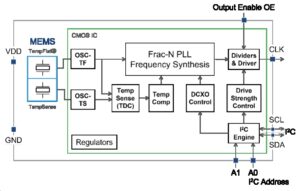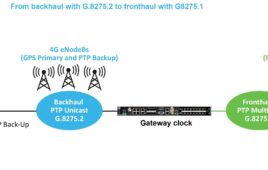The Elite X Super-TCXO from SiTime provides stable timing from 1 MHz to 60 MHz for edge computing, vehicles, and cellular base stations.
Communications depends on timing, which start with an oscillator. The SiT5501 Elite X Super-TCXO from SiTime produces clock signals at any frequency from 1 MHz to 60 MHz, which you can then multiply up to your needed clock or data rate. For most devices, the output frequency is set at the factory; you need to specify it at time of order. An available I2C interface lets you set the device’s output frequency. The digital frequency tuning lets you compensate for frequency shifts cause by noise.
Because you need to use a frequency multiplier to achieve the final clock signal, you need to start with a stable oscillator. The Elite X features ±10 ppb stability from over a temperature range of -40 to 105°C. Temperature stability is important because “more and more electronics will be outdoors and subject to high operating temperature,” said SiTime’s Piyush Sevalia in a discussion with EE World. “5G radios such as small cells, edge computing devices, and vehicles all operate outdoors and must be resistant to temperature, thermal shock, and vibration.”
During our discussion, Sevalia claimed that the Elite X solves the stability and reliability issue surrounding quartz oscillators. “Quartz has cold-temperature startup problems and the output frequency often goes out of spec.”
The SiT5501’s ±0.5 ppb/°C frequency slope (ΔF/ΔT), 0.5°C/min ramp keep timing good enough for telecom applications such as handoffs between base stations.
Other applications include IEEE 1588 boundary and grandmaster clocks and remote sensors. Remote sensor modules could need to maintain time for up to 30 days without connecting to a network. That requires reduced energy consumption. The SiT5501 uses 110 mW of power at VDD=2.5 V, which SiTime claims is ¼ the power consumed other quartz mini-OCXOs. The device package size is 7.0 mm × 5.0 mm.






Tell Us What You Think!